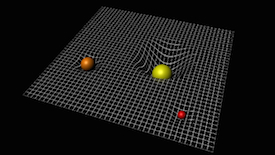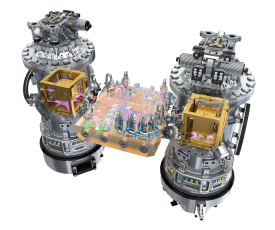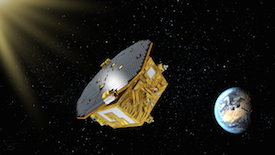What LISA Pathfinder is doing and how
 |
|
Artistic view of massive bodies bending the structure of spacetime. Credit: ESA–C.Carreau |
These invisible contours define how matter moves through space, rather like train tracks guiding a locomotive. In the case of general relativity, the paths are called geodesics.
For LISA Pathfinder to work it must detect this motion. The spacecraft is therefore equipped with two test masses, which will float inside its body, and the spacecraft will sense their motion relative to each other.
The test masses will naturally follow geodesics. If the spacecraft manages to isolate them from all other influences as hoped, then the motion will be purely geodesic and the two test masses will move in perfect synchrony.
If there is an external force acting then the test masses will appear to move differently from one another and the spacecraft will measure an acceleration between them.
 |
| The LISA Technology Package core assembly, hosting the two test masses and, between them, the optical bench interferometer. Credit: ESA/ATG medialab |
The spacecraft keeps track of the test masses by using an ultrastable laser interferometer. A laser beam is split in two, bounced off the surfaces of the test masses and then recombined. Changes in the interference signal between the beams betray any movement between the two test masses down to a trillionth of a metre (a picometre).
Understanding what this relative motion means and making sure that it is coming solely from gravity is the job of the analysis team.
The Mission Operations Centre is at the European Space Operations Centre (ESOC), Darmstadt, Germany, where the spacecraft controllers are based. During the science operations phase, when the LISA Technology Package experiments are being run, the Science and Technology Operations Centre (STOC; usually based at the European Space Astronomy Centre - ESAC, Villafranca, Spain) and the scientists will also be at ESOC because of the need for constant interaction between the scientists running the experiment and the people 'flying' LISA Pathfinder.
 |
| Artistic view of LISA Pathfinder in space. Credit: ESA–C.Carreau |
LISA Pathfinder will be in touch with the ground for approximately 8 hours every day. It will downlink primarily through ESA’s Cebreros and Malargüe tracking stations in Spain and Argentina, respectively. The first data to be transmitted every day tell the controllers and scientists about the health of the spacecraft and the experiment.
The rest of the day is spent downloading the actual scientific data. This will usually be complete by about 18:00 UTC, and then the data are transferred and formatted for the scientists' computers, a process called 'ingestion'. So it is the evening before any analysis can take place.
The first analysis is just a quick look to make sure the data look sensible. This takes until the late evening to complete. If everything checks out, the full analysis will begin first thing the next day. It can take days to analyse the data and document the results. Therefore to keep up with the data acquisition two teams must work in shifts. Because of the experimental nature of the mission, the scientific data are essential to inform what else needs doing with the spacecraft. New experiments will be based upon the results of the previous ones. In this way, ESA will learn how to control and make use of a gravitational-wave observatory.
The scientists and operators at ESOC are also responsible for turning these follow-on scientific requests into command sequences that LISA Pathfinder's main computer will understand. The requests are tested in a computer simulation to make sure that they are safe to perform and then coded for transmission to the spacecraft. And the analysis cycle starts all over again.
